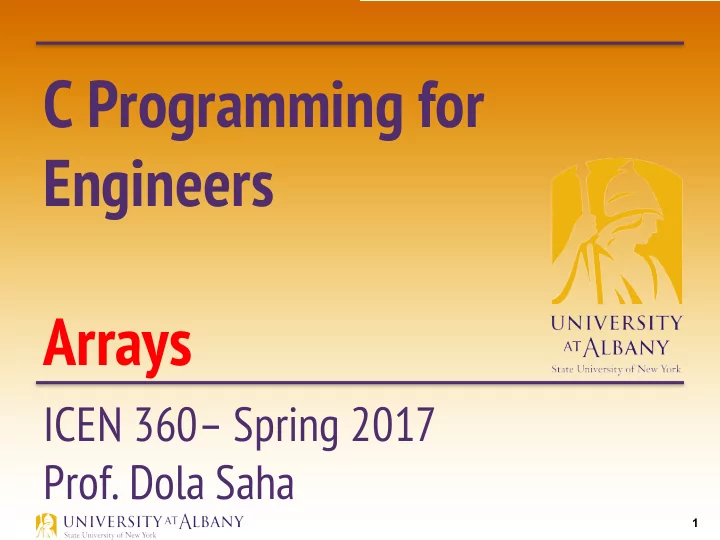

C Programming for Engineers Arrays ICEN 360– Spring 2017 Prof. Dola Saha 1
Passing Arrays to Functions Ø To pass an array argument to a function, specify the array’s name without any brackets. Ø For example, int hourlyTemperatures[HOURS_IN_A_DAY]; modifyArray(hourlyTemperatures, HOURS_IN_A_DAY); the function call passes array hourlyTemperatures and its size to function modifyArray . Ø The name of the array evaluates to the address of the first element of the array. Ø The called function can modify the element values in the callers’ original arrays. 2
Passing Array to Functions (1) 3
Passing Array to Functions (2) 4
Passing Array to Functions (3) 5
Passing Array to Functions (4) 6
Memory location of Arrays Ø array , &array and &array[0] have the same value, namely 0012FF78 7
Protecting Array Elements Ø Function tryToModifyArray is defined with parameter const int b[] , which specifies that array b is constant and cannot be modified. Ø The output shows the error messages produced by the compiler—the errors may be different for your compiler. 8
Classwork Assignment Ø Search an Array: Write a program to initialize an array of size S with an initializer list. Also get a value for num1 from user. Pass the array as well as num1 to a function. Within the function, check each element of array whether it matches num1. If it matches, return 1, else return 0 to the main function. 9
Binary Search – searching in a sorted array Ø The linear searching method works well for small or unsorted arrays. Ø However, for large arrays linear searching is inefficient . Ø If the array is sorted, the high-speed binary search technique can be used. Ø The binary search algorithm eliminates from consideration one-half of the elements in a sorted array after each comparison. 10
Binary Search – searching in a sorted array Ø The algorithm locates the middle element of the array and compares it to the search key. Ø If they’re equal, the search key is found and the index of that element is returned. Ø If they’re not equal, the problem is reduced to searching one-half of the array. Ø If the search key is less than the middle element of the array, the first half of the array is searched, otherwise the second half of the array is searched. 11
Demo Ø Demo from Princeton https://www.cs.princeton.edu/courses/archive/fall06/cos226/demo/demo- bsearch.ppt 12
Binary Search – C code (1) 13
Binary Search – C code (2) 14
Binary Search – C code (3) 15
Binary Search – C code (4) 16
Binary Search – C code (5) 17
Binary Search – C code (6) 18
Binary Search – C code (7) 19
Multidimensional Arrays Ø Arrays in C can have multiple indices. Ø A common use of multidimensional arrays is to represent tables of values consisting of information arranged in rows and columns . Ø Multidimensional arrays can have more than two indices. 3x4 Array 20
Initialization Ø Where it is defined § Braces for each dimension o int b[2][2] = {{1, 2}, {3, 4}}; § If there are not enough initializers for a given row, the remaining elements of that row are initialized to 0 . o int b[2][2] = {{1}, {3, 4}}; § If the braces around each sublist are removed from the array1 initializer list, the compiler initializes the elements of the first row followed by the elements of the second row. o int b[2][2] = {1, 2, 3, 4}; 21
Multidimensional Array Example Code (1) 22
Multidimensional Array Example Code (2) 23
Two Dimensional Array Manipulation Ø Example § studentGrades[3][4] § Row of the array represents a student. § Column represents a grade on one of the four exams the students took during the semester. Ø The array manipulations are performed by four functions. § Function minimum determines the lowest grade of any student for the semester. § Function maximum determines the highest grade of any student for the semester. § Function average determines a particular student’s semester average. § Function printArray outputs the two-dimensional array in a neat, tabular format. 24
2D Array Manipulation Code (1) 25
2D Array Manipulation Code (2) 26
2D Array Manipulation Code (3) 27
2D Array Manipulation Code (4) 28
2D Array Manipulation Code (5) 29
2D Array Manipulation Code (6) 30
2D Array Manipulation Code (7) 31
Classroom Assignment Ø Matrix Addition/Subtraction – two matrices should have same number of rows and columns. Addition Subtraction https://en.wikipedia.org/wiki/Matrix_addition 32
Variable Length Array Ø In early versions of C, all arrays had constant size. Ø If size is unknown at compilation time § Use dynamic memory allocation with malloc Ø The C standard allows a variable-length array § An array whose length, or size, is defined in terms of an expression evaluated at execution time. 33
Variable Length Array Code (1) 34
Variable Length Array Code (2) 35
Variable Length Array Code (3) 36
Variable Length Array Code (4) 37
Variable Length Array Code (5) 38
Recommend
More recommend